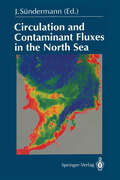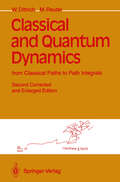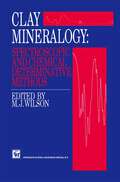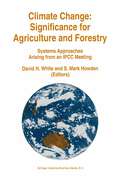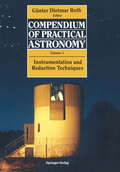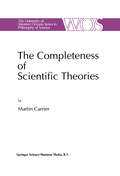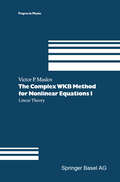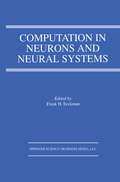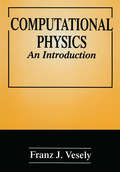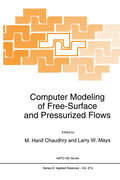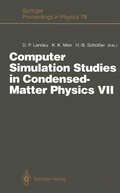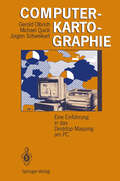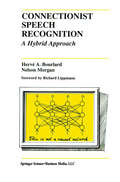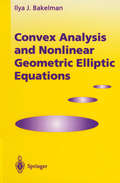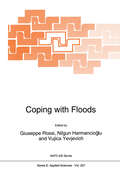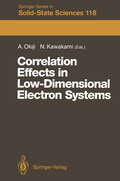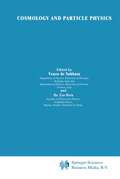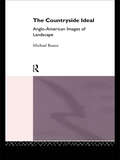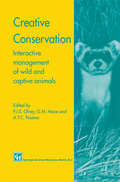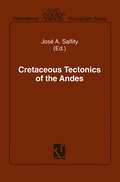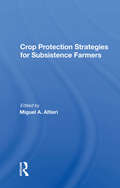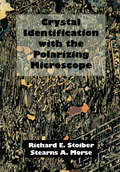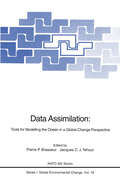- Table View
- List View
Circulation and Contaminant Fluxes in the North Sea
by Jürgen SündermannIn this publication you will find a comprehensive data set of the North Sea ecosystem, including the distribution and the fate of contaminants, their transport paths and their analysis by means of numerical models. This book presents the results of the interdisciplinary German research project ZISCH ('Zirkulation und Schadstoffumsatz in der Nordsee') encompassing oceanographers, meteorologists, marine biologists and chemists.
Classical and Quantum Dynamics: from Classical Paths to Path Integrals
by Walter Dittrich Martin ReuterGraduate students wishing to become familiar with advanced computational strategies in classical and quantum dynamics will find in the one source both the fundamentals of a standard course as well as a detailed treatment of the time-dependent oscillator, Chern-Simons mechanics, the Maslov anomaly and the Berry phase, illustrated by many worked examples throughout the text. This second edition has been enlarged with a new chapter on topological phases in planar electrodynamics, and a discussion of the Aharonov-Bohm effect.
Clay Mineralogy: Spectroscopic and Chemical Determinative Methods
by M. J. WilsonA knowledge of clay is important in many spheres of scientific endeav our, particularly in natural sciences such as geology, mineralogy and soil science, but also in more applied areas like environmental and mater ials science. Over the last two decades research into clay mineralogy has been strongly influenced by the development and application of a num ber of spectroscopic techniques which are now able to yield information about clay materials at a level of detail that previously would have seemed inconceivable. This information relates not only to the precise characterization of the individual clay components themselves, but also to the ways in which these components interact with a whole range of absorbate molecules. At present, however, the fruits of this research are to be found principally in a somewhat widely dispersed form in the scientific journals, and it was thus considered to be an appropriate time to bring together a compilation of these spectroscopic techniques in a way which would make them more accessible to the non-specialist. This is the primary aim of this book. The authors of the various chapters first describe the principles and instrumentation of the individual spectro scopic techniques, assuming a minimum of prior knowledge, and then go on to show how these methods have been usefully applied to clay mineralogy in its broadest context.
Climate Change: Systems Approaches Arising from an IPCC Meeting
by S. MarkHowden David H. WhiteSocieties throughout the world depend on food, fiber and forest products. Continuity and security of agricultural and forest production are therefore of paramount importance. Predicted changes in climate could be expected to alter, perhaps significantly, the levels and relative agricultural and forestry production of different nations over the next few decades. Agriculture and forestry are also likely to influence the rate and magnitude of such change, as they can be both significant sources and sinks of a number of greenhouse gases. Adaptive management strategies therefore need to be formulated and implemented for these sectors, to enable them to both adapt to future environmental change, and to limit greenhouse gas emissions. This book arose from an international workshop held in Canberra, Australia, under the auspices of the former IPCC Working Group III - Agriculture, Forestry and Other Human Activities Sub-Group (AFOS). A number of leading speakers at the workshop were approached to encapsulate the concepts discussed and developed at this workshop. The resulting papers make up this volume. The book promotes a greater understanding of the major sources and sinks of greenhouse gases within intensive and extensive cropping and animal production systems, and of agroforestry. It highlights the need to adopt a holistic systems approach to monitoring and reducing greenhouse gas emissions and assessing impacts, and to integrate climate change-related goals and activities with other issues, such as biodiversity, desertification, and sustainable agriculture and forestry.
Compendium of Practical Astronomy: Volume 1: Instrumentation and Reduction Techniques
by H. J. Augensen W. D. HeintzIt is a pleasure to present this work, which has been well received in German-speaking countries through four editions, to the English-speaking reader. We feel that this is a unique publication in that it contains valuable material that cannot easily-if at all-be found elsewhere. We are grateful to the authors for reading through the English version of the text, and for responding promptly (for the most part) to our queries. Several authors have supplied us, on their own initiative or at our suggestion, with revised and updated manuscripts and with supplementary English references. We have striven to achieve a translation of Handbuch for Sternfreunde which accurately presents the qualitative and quantitative scientific principles con tained within each chapter while maintaining the flavor of the original Ger man text. Where appropriate, we have inserted footnotes to clarify material which may have a different meaning and/or application in English-speaking countries from that in Germany. When the first English edition of this work, Astronomy: A Handbook (translated by the late A. Beer), appeared in 1975, it contained 21 chapters. This new edition is over twice the length and contains 28 authored chap ters in three volumes. At Springer's request, we have devised a new title, Compendium of Practical Astronomy, to more accurately reflect the broad spectrum of topics and the vast body of information contained within these pages.
The Completeness of Scientific Theories: On the Derivation of Empirical Indicators within a Theoretical Framework: The Case of Physical Geometry (The Western Ontario Series in Philosophy of Science #53)
by Martin CarrierEarlier in this century, many philosophers of science (for example, Rudolf Carnap) drew a fairly sharp distinction between theory and observation, between theoretical terms like 'mass' and 'electron', and observation terms like 'measures three meters in length' and 'is _2° Celsius'. By simply looking at our instruments we can ascertain what numbers our measurements yield. Creatures like mass are different: we determine mass by calculation; we never directly observe a mass. Nor an electron: this term is introduced in order to explain what we observe. This (once standard) distinction between theory and observation was eventually found to be wanting. First, if the distinction holds, it is difficult to see what can characterize the relationship between theory :md observation. How can theoretical terms explain that which is itself in no way theorized? The second point leads out of the first: are not the instruments that provide us with observational material themselves creatures of theory? Is it really possible to have an observation language that is entirely barren of theory? The theory-Iadenness of observation languages is now an accept ed feature of the logic of science. Many regard such dependence of observation on theory as a virtue. If our instruments of observation do not derive their meaning from theories, whence comes that meaning? Surely - in science - we have nothing else but theories to tell us what to try to observe.
The Complex WKB Method for Nonlinear Equations I: Linear Theory (Progress in Mathematical Physics #16)
by Victor P. MaslovComputation in Neurons and Neural Systems
by Frank EeckmanComputation in Neurons and Neural Systems contains the collected papers of the 1993 Conference on Computation and Neural Systems which was held between July 31--August 7, in Washington, DC. These papers represent a cross-section of the state-of-the-art research work in the field of computational neuroscience, and includes coverage of analysis and modeling work as well as results of new biological experimentation.
Computational Physics: An Introduction
by Franz J. VeselyAuthor Franz J. Vesely offers students an introductory text on computational physics, providing them with the important basic numerical/computational techniques. His unique text sets itself apart from others by focusing on specific problems of computational physics. The author also provides a selection of modern fields of research. Students will benefit from the appendixes which offer a short description of some properties of computing and machines and outline the technique of 'Fast Fourier Transformation.'
Computer Modeling of Free-Surface and Pressurized Flows (NATO Science Series E: #274)
by M. Hanif Chaudhry L. MaysComputers are widely used for the analysis, design, and operation of water resource projects. This gives accurate results, allowing the analysis of complex systems which may not have been possible otherwise, and the investigation and comparison of several different alternatives in a short time, thereby reducing the project costs, optimizing design, and efficient utilization of resources. This volume compiles an edited version of the lecture notes specially prepared by 14 well-known European and North American researchers. Part I deals with free-surface flows. Governing equations are derived and their solution by the finite-difference, finite-element, and boundary-integral methods are discussed. Then, turbulence models, three-dimensional models, dam-break flow models, sediment transport models, and flood routing models are presented. Part II is related to the modeling of steady and transient pressurized flows. Governing equations for both single and two-component flows are derived and numerical methods for their solution are presented. The modeling of water quality in pipe networks, of cooling water systems, and slow and rapid transients is then discussed.
Computer Simulation Studies in Condensed-Matter Physics VII: Proceedings of the Seventh Workshop Athens, GA, USA, 28 February – 4 March 1994 (Springer Proceedings in Physics #78)
by David P. Landau K. K. Mon Heinz-Bernd SchüttlerComputer Simulation Studies in Condensed-Matter Physics VII provides a broad overview of recent developments. Presented at the recent workshop, it contains the invited and contributed papers which describe new physical results, simulational techniques and ways of interpreting simulational data. Both classical and quantum systems are discussed.
Computerkartographie: Eine Einführung in das Desktop Mapping am PC
by Gerold Olbrich Michael Quick Jürgen SchweikartEndlich gibt es ein deutschsprachiges Buch, das umfassend die Theorie und Praxis der Computerkartographie darstellt. Es ist verständlich geschrieben, enthält zahlreiche Abbildungen und Beispiele und führt die Leistungsmerkmale gängiger PC-Programme sowie die Bezugsadressen für Koordinatendaten und Software auf.
Connectionist Speech Recognition: A Hybrid Approach (The Springer International Series in Engineering and Computer Science #247)
by Hervé A. Bourlard Nelson MorganConnectionist Speech Recognition: A Hybrid Approach describes the theory and implementation of a method to incorporate neural network approaches into state of the art continuous speech recognition systems based on hidden Markov models (HMMs) to improve their performance. In this framework, neural networks (and in particular, multilayer perceptrons or MLPs) have been restricted to well-defined subtasks of the whole system, i.e. HMM emission probability estimation and feature extraction. The book describes a successful five-year international collaboration between the authors. The lessons learned form a case study that demonstrates how hybrid systems can be developed to combine neural networks with more traditional statistical approaches. The book illustrates both the advantages and limitations of neural networks in the framework of a statistical systems. Using standard databases and comparison with some conventional approaches, it is shown that MLP probability estimation can improve recognition performance. Other approaches are discussed, though there is no such unequivocal experimental result for these methods. Connectionist Speech Recognition is of use to anyone intending to use neural networks for speech recognition or within the framework provided by an existing successful statistical approach. This includes research and development groups working in the field of speech recognition, both with standard and neural network approaches, as well as other pattern recognition and/or neural network researchers. The book is also suitable as a text for advanced courses on neural networks or speech processing.
Convex Analysis and Nonlinear Geometric Elliptic Equations
by Ilya J. BakelmanInvestigations in modem nonlinear analysis rely on ideas, methods and prob lems from various fields of mathematics, mechanics, physics and other applied sciences. In the second half of the twentieth century many prominent, ex emplary problems in nonlinear analysis were subject to intensive study and examination. The united ideas and methods of differential geometry, topology, differential equations and functional analysis as well as other areas of research in mathematics were successfully applied towards the complete solution of com plex problems in nonlinear analysis. It is not possible to encompass in the scope of one book all concepts, ideas, methods and results related to nonlinear analysis. Therefore, we shall restrict ourselves in this monograph to nonlinear elliptic boundary value problems as well as global geometric problems. In order that we may examine these prob lems, we are provided with a fundamental vehicle: The theory of convex bodies and hypersurfaces. In this book we systematically present a series of centrally significant results obtained in the second half of the twentieth century up to the present time. Particular attention is given to profound interconnections between various divisions in nonlinear analysis. The theory of convex functions and bodies plays a crucial role because the ellipticity of differential equations is closely connected with the local and global convexity properties of their solutions. Therefore it is necessary to have a sufficiently large amount of material devoted to the theory of convex bodies and functions and their connections with partial differential equations.
Coping with Floods (NATO Science Series E: #257)
by Giuseppe Rossi Nilgun B. Harmanciogammalu V. YevjevichFloods are natural hazards whose effects can deeply affect the economic and environmental equilibria of a region. Quality of life of people living in areas close to rivers depends on both the risk that a flood would occur and the reliability of flood forecast, warning and control systems. Tools for forecasting and mitigating floods have been developed through research in the recent past. Two innovations currently influence flood hazard mitigation, after many decades of lack of significant progress: they are the development of new technologies for real-time flood forecast and warning (based on weather radars and satellites) and a shift from structural to non-structural flood control measures, due to increased awareness of the importance of protecting the environment and the adverse impacts of hydraulic works on it. This book is a review of research progress booked in the improvements of forecast capability and the control of floods. Mostly the book presents the results of recent research in hydrology, modern techniques of real-time forecast and warning, and ways of controlling floods for smaller impacts on the environment. A number of case studies of floods in different geographical areas are also presented. Scientists and specialists working in fields of hydrology, environmental protection and hydraulic engineering will appreciate this book for its theoretical and practical content.
Correlation Effects in Low-Dimensional Electron Systems: Proceedings of the 16th Taniguchi Symposium Kashikojima, Japan, October 25–29, 1993 (Springer Series in Solid-State Sciences #118)
by Ayao Okiji Norio KawakamiCorrelation Effects in Low-Dimensional Electron Systems describes recent developments in theoretical condensed-matter physics, emphasizing exact solutions in one dimension including conformal-field theoretical approaches, the application of quantum groups, and numerical diagonalization techniques. Various key properties are presented for two-dimensional, highly correlated electron systems.
Cosmology and Particle Physics (Nato Science Series C: #427)
by V. De Sabbata Ho Ho Tso-HsiuIn recent years there has been a steadily increasing cross-fertilization between cosmology and particle physics, on both the theoretical and experimental levels. Particle physics has provided new experimental data from the big accelerators in operation, and data from space satellites are accumulating rapidly. Cosmology is still one of the best laboratories for testing particle theory. The present work discusses such matters in the context of inflation, strings, dark matter, neutrinos and gravitational wave physics in the very early universe, field theory at the Planck scale, and high energy physics. A particular emphasis has been placed on a new topology for spatial infinity, on the relation between temperature and gravitational potential, a canonical formulation of general relativity, the neutrino mass, spin in the early universe, the measurement of gravity in the 10--100 m range, galaxy--galaxy and cluster--cluster correlation, black holes, string theory and string/string duality. The work also presents a beautiful review of high energy elementary particle physics, treating the meaning, status and perspectives of unification and standard model gauge couplings.
The Countryside Ideal: Anglo-American Images of Landscape
by Michael Bunce`God made the country, man made the town.' William Cowper's words, written two centuries ago, underline an idealisation of rural life and landscape which persists to this day. What are the main historical processes and ideas underlying the continuing attachment to the countryside? How have these shaped popular values and lifestyles influenced artistic expression, defined attitudes to nature, country life and 8andscape, and affected the development of both rural and urban landscapes? What are the consequences for society and the environment? These are the central questions addressed in this book. The Countryside Ideal draws together diverse images of landscape to explore this preoccupation with place, culture and representation in the West.
The Countryside Ideal: Anglo-American Images of Landscape
by Michael Bunce`God made the country, man made the town.' William Cowper's words, written two centuries ago, underline an idealisation of rural life and landscape which persists to this day. What are the main historical processes and ideas underlying the continuing attachment to the countryside? How have these shaped popular values and lifestyles influenced artistic expression, defined attitudes to nature, country life and 8andscape, and affected the development of both rural and urban landscapes? What are the consequences for society and the environment? These are the central questions addressed in this book. The Countryside Ideal draws together diverse images of landscape to explore this preoccupation with place, culture and representation in the West.
Creative Conservation: Interactive management of wild and captive animals
by A. T. C.Feistner G. M. Mace P. J. S.OlneyPast progress and future challenges R.J. Wheater Royal Zoological Society of Scotland, Edinburgh, UK. In the past two decades much has been achieved in the sphere of breeding endangered species, and we should be pleased that our co operative efforts have already borne so much fruit. However, on balance and despite the best efforts of conservationists, the position of wildlife in the wild places where they are best conserved has become worse, often dramatically worse. Before returning to the United Kingdom in 1972, I was in Uganda for 16 years, most of which time was spent as Chief Warden of Murchison Falls National Park. Our main problem was that an over-population of large mammals was having a devastating impact on the habitat. Devas tation was being wrought on woodland areas by the arrival of large numbers of elephants into the sanctuary of the Park, following changes in land use in the areas outside the Park. These changes were in response to the requirements of an ever-expanding human population.
Crop Protection Strategies For Subsistence Farmers
by Miguel A AltieriTop-down approaches to pest management, relying on agrochemical inputs that can be scarce, expensive, ecologically toxic, or inaccessible, have repeatedly failed to solve pest problems that affect small farmers in developing countries. Crop Protection Strategies for Subsistence Farmers offers an alternative. Drawing on examples from Latin Am
Crop Protection Strategies For Subsistence Farmers
by Miguel A AltieriTop-down approaches to pest management, relying on agrochemical inputs that can be scarce, expensive, ecologically toxic, or inaccessible, have repeatedly failed to solve pest problems that affect small farmers in developing countries. Crop Protection Strategies for Subsistence Farmers offers an alternative. Drawing on examples from Latin Am
Crystal Identification with the Polarizing Microscope
by R.E. Stoiber S.A. MorseSome of the simpler measurements of optical mineralogy are so precise and powerful that they give satisfaction to beginning students. Not long after mastering the strike and dip of rock surfaces with the Brunton compass, many geology students are able to determine precisely the identity of quartz, or the anorthite content of plagioclase, or the magne sium ratio of pyroxene with the polarizing or petrographic microscope, by means of measuring refractive index to better than one part in a thousand. Very little training and almost no theory are needed to achieve these skills. But there inevitably comes a time when theory is needed, either to get on with the art, or simply to reconstruct from first principles what is going on, when rote memory fails. In this book we hope to provide both the rote methods and the theoretical background for practitioners at all levels of experience. We draw from several careers-ours, our colleagues', and our students' -in teaching the subject at various levels of sophistication. Our book is intended to serve the needs of industrial and forensic scientists as well as petrogra phers who deal with rocks. Much of our treatment is based on new research, both in matters of presentation and in the optical determination of minerals and other materials.
Data Assimilation: Tools for Modelling the Ocean in a Global Change Perspective (Nato ASI Subseries I: #19)
by Jacques C. J.Nihoul Pierre P. BrasseurData assimilation is considered a key component of numerical ocean model development and new data acquisition strategies. The basic concept of data assimilation is to combine real observations via estimation theory with dynamic models. Related methodologies exist in meteorology, geophysics and engineering. Of growing importance in physical oceanography, data assimilation can also be exploited in biological and chemical oceanography. Such techniques are now recognized as essential to understand the role of the ocean in a global change perspective. The book focuses on data processing algorithms for assimilation, current methods for the assimilation of biogeochemical data, strategy of model development, and the design of observational data for assimilation.
